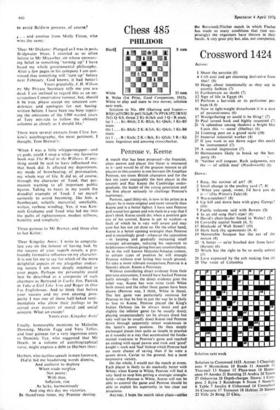Chess 485
PHILIDOR
B. Weiss (1st Prize, Good Companions, 1915). White to play and mate in two moves; solution next week.
Solution to No. 484 (Hartong and Ivanov- B5Q1/p2N2B1/2r pn3/31c2qR/7b/PP1K1P2/3RN3/ 5b2) Q-K8, threat 2 Kt-Kt6ch and 3 Q x R mate.
(a) 1 Kt-B4ch; 2 K-B2ch, Kt-Q6ch; 3 Kt-B3 mate.
(b) 1 Kt-BSch; 2 K-K3ch, Kt-Q6ch; 3 Kt-B4 mate.
(c) 1 . B x Ktch; 2 K x Bch, Kt-Q5ch; 3 RxKt mate. Ingenious and amusing cross:checker.
Penrose v. Keene
A match that has been proposed—the financier, chess patron and player Jim Slater is interested in it—and would be of the greatest interest to all players in this country is one between Dr Jonathan Penrose, ten times British champion and for the last ten years unarguably the best player in the country and Ray Keene the Cambridge under- graduate, the leader of the young generation and the first player seriously to challenge Penrose's supremacy.
Penrose, aged thirty-six, is now in his prime as a player; he is more original and more versatile than Keene and is a better fighter. I have seen Penrose pull round lost games and win them in a way that I don't think Keene could do; when a position gets out of his-control, Keene is apt to weaken—a fault of which he is very well aware and may cure but has not yet done so. On the other hand, Keene is a better opening strategist than Penrose and is exceedingly good—whatever the opposition —in keeping and gradually increasing small strategic advantages, reducing his opponent to helplessness without giving him any counterchance. As in the well known Hercules/Antaeus contest, in certain types of position he will strangle Penrose without ever letting him touch ground. To take a more relevant comparison, Penrose is a Spassky player, Keene a Petrosian.
Without considering direct evidence from their previous encounters, I would have backed Penrose fairly strongly—but the direct evidence goes the other way. Keene has won twice (with White both times) and the other three games have been drawn (Penrose was, I think, White in these). The last game was particularly ominous for Penrose in that he lost in just the way he is likely to lose to Keene. Penrose played the King's Indian Defence (as he always does) and got slightly the inferior game (as he usually does); playing unspectacularly (as he always does) but very well (as he usually does) Keene tied Penrose down through apparently minor weaknesses in the latter's pawn position. He then simply exchanged pieces (not quite as simple in practice as it sounds) in a way that accentuated the funda- mental weakness in Penrose's game and reached an ending with equal pawns and rook and 'good' knight v. rook and 'bad' bishop which Penrose had no more chance of saving than if he were a queen down. Caviar to the general, but a most impressive victory.
On the whole, I would put the match at evens. Each player is likely to do markedly better with White; when Keene is White, Penrose will find it very hard to stop him getting a strategic strangle- hold—when Penrose is White, Keene will not be able to control the game and Penrose should be able to exploit his superiority in less clear cut situations.
Anyway, I hope the match takes place—unlace
the Botwinnik/Fischer match in which Fischer has made so many conditions that (not sur- prisingly) the organisers have thrown in their hands. A very great pity but, alas, not unexpected.


































 Previous page
Previous page